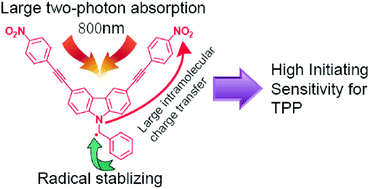Design of high efficiency for two-photonpolymerization initiator: combination of radical stabilization and large two-photon cross-section achieved by N-benzyl 3,6-bis(phenylethynyl)carbazole derivatives
Abstract
Novel A–π–D–π–A V-shaped

* Corresponding authors
a
Laboratory of Organic NanoPhotonics, Technical Institute of Physics and Chemistry, Chinese Academy of Sciences, No.2, Beiyitiao, Zhongguancun, Haidian District, Beijing, China
E-mail:
chenwq7315@mail.ipc.ac.cn, xmduan@mail.ipc.ac.cn
Fax: +86-10-82543597
Tel: +86-10-82543596
b Graduate School of Chinese Academy of Sciences, Chinese Academy of Sciences, Zhongguancunbeiyitiao No.2, Haidian, Beijing, China
c
Nanophotonics Laboratory, RIKEN (The Institute of Physical and Chemical Research), 2-1 Hirosawa, Wako-shi, Saitama, Japan
E-mail:
t-tanaka@riken.jp
Novel A–π–D–π–A V-shaped

 Please wait while we load your content...
Something went wrong. Try again?
Please wait while we load your content...
Something went wrong. Try again?
J. Xing, W. Chen, J. Gu, X. Dong, N. Takeyasu, T. Tanaka, X. Duan and S. Kawata, J. Mater. Chem., 2007, 17, 1433 DOI: 10.1039/B616792F
To request permission to reproduce material from this article, please go to the Copyright Clearance Center request page.
If you are an author contributing to an RSC publication, you do not need to request permission provided correct acknowledgement is given.
If you are the author of this article, you do not need to request permission to reproduce figures and diagrams provided correct acknowledgement is given. If you want to reproduce the whole article in a third-party publication (excluding your thesis/dissertation for which permission is not required) please go to the Copyright Clearance Center request page.
Read more about how to correctly acknowledge RSC content.
 Fetching data from CrossRef.
Fetching data from CrossRef.
This may take some time to load.
Loading related content
